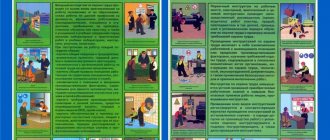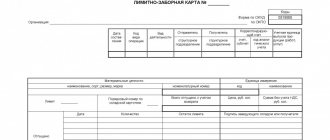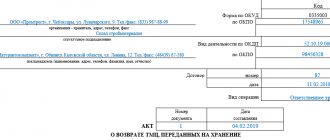Home / Labor Law / Personnel Management / Personnel training and certification
Back
Published: 05/09/2017
Reading time: 9 min
0
2479
Ensuring labor safety and eliminating factors that pose a risk to the life or health of workers is one of the main obligations of every employer. To achieve this goal, he must periodically inspect the workplaces of his subordinates and eliminate all possible risks.
The document that is drawn up is called a workplace map. Its purpose, structure and filling rules are worth considering in more detail.
- Legislation
- Purpose of the document
- What points are included in the map? Comprehensive assessment of working conditions (WC) that are present at a specific workplace (or in a group of such places)
- Injury safety assessment
- Establishment of additional benefits and compensations
Dear readers! To solve your problem, call hotline 8 or ask a question on the website. It's free.
Ask a Question
Why is it necessary to characterize working conditions in the workplace?
Characteristics of a workplace is a concept that is not fixed at the level of federal regulations, but is quite often used in industry and regional regulations.
For example, in paragraph 4.2.2 of the resolution of the Chief State Doctor of the Russian Federation dated April 4, 2003 No. 32, which established the sanitary rules for cargo transportation on railways, it is stated that in the process of organizing workplaces, a labor organization project must be drawn up, the structure of which includes the characteristics of the worker places _
Another document, Order No. 7/33 of the Department of Health of the Tyumen Region dated 06/04/2012, states that the characteristics of the workplace should be recorded in the reports of medical specialists on their work, which are reviewed by the certification commission that establishes qualification categories.
At the same time, the requirements for such a document as a description of a workplace are not enshrined in any legal regulations. So the specific format of this document should be developed based on the current tasks facing the employee of the organization responsible for personnel document flow.
In the structure of job characteristics, it is reasonable to record the following parameters:
- completeness, equipment of the workplace;
- indicators of illumination, noise level and other physical characteristics of the room in which the workplace is located;
- the specifics of the labor function performed by employees in the workplace.
In some cases, documents related to the characteristics of jobs are required for subsequent submission to the VTEK (medical labor expert commission), which establishes disability groups for citizens.
Workplace organization
One of the most important elements of labor organization at an enterprise (organization) is the improvement of planning, organization and maintenance of workplaces in order to create at each of them the necessary conditions for highly productive and high-quality work with the least possible physical effort and minimal nervous tension. The workplace is the primary link in the production structure of an enterprise; it is the object of labor organization in all its above-mentioned areas. The diagram below illustrates aspects of the analysis of the concept of “workplace”. A workplace
is
an area where labor is applied, determined on the basis of labor and other applicable standards and equipped with the necessary means intended for the work of one or more performers. The workplace as a place of employment for a person predetermines working conditions (normal, difficult), work and rest regimes, and the nature of the worker’s work (varied, monotonous, etc., Fig. 1).
Rice. 1. Aspects of the concept of “workplace”
In organizational, technical and ergonomic aspects, the workplace
- this is a part of the production space of a workshop or department, equipped with means of labor (equipment, tools, devices) to perform a relatively isolated part of the production process by one or a group of employees. This definition involves the rationalization of the selection and placement of technical means that ensure the safe and efficient activities of people in the relevant part of the enterprise unit.
In terms of ensuring employment, the workplace
- this is the scope of activity of one employee or a set of functions that he must perform. This aspect is focused on providing the enterprise with personnel and the population with work.
Workplace
- part of the production space with all the main and auxiliary technological equipment, equipment, inventory, tools, work furniture and special devices located on it, necessary for the production of a certain type of work.
Inside the workplace, a work zone is allocated - part of a three-dimensional space within which all the main labor actions of the employee are carried out. It is the most active part of the workplace and special requirements are imposed on its organization: compliance with the anthropometric and biomechanical parameters of a person, ensuring a physiologically rational working posture, the reach of body organs to objects of work, tools or controls of machines and mechanisms, as well as guaranteeing the safety of labor actions and harmless working conditions. Requirements for the organization of the workplace and work area are developed by a special branch of science - ergonomics
, the task of which is to study the functional capabilities of a person in labor processes and develop recommendations for creating optimal working conditions that ensure compliance of equipment designs, technology and working conditions with the psychophysiological characteristics of the human body.
All jobs are classified
according to a number of signs.
By degree of mechanization
they are divided into five groups: manual, machine-manual, mechanized, automated and instrumental.
When working manually
In workplaces, all labor processes are carried out manually, using hand tools; the main source of energy for transforming objects of labor is human physical strength.
To machine-manual
workplaces include the processing (transformation) of objects of labor by mechanisms and due to external energy (electrical, thermal, kinetic), but with the direct participation of the worker. Examples include working on metal-cutting or woodworking machines with manual feed, drilling with hand-held pneumatic hammer drills, cultivating the soil with hand-held mechanized cultivators, sewing on a household sewing machine, etc.
Mechanized
workplaces differ from manual and machine-manual ones in that the main technological processes are completely carried out by machines and mechanisms, and the worker retains only the function of controlling the machines, i.e. human energy is spent on management, and not on direct transformation of the subject of labor. Mechanized jobs include the jobs of semi-automatic machine operators, vehicle drivers, excavator or bulldozer operators, drillers for mechanical well drilling, and many other professions and types of work where a machine operates, but not automatically, but under constant human control.
On automated
workplaces, the entire technological process is carried out by a machine, machine or automatic unit without the participation of a worker, who retains the function of starting and stopping the machine, monitoring its operation and, if necessary, setting up and adjusting. The employee has a significant portion of operational time freed up, which is directed to multi-machine maintenance and a significant increase in labor productivity.
Hardware
workplaces are equipped with various devices; they influence the object of labor using thermal, electrical, chemical or biological energy. As in automated processes, the worker only observes and controls the progress of hardware processes and, if necessary, adjusts them.
Based on specialization
All jobs are divided into specialized and universal.
At specialized
workplaces equipped with special-purpose equipment, the same or similar operations and types of work can be performed (workstations for a stamper, heat treatment operator, driller, calculating machine operator, etc.).
At universal workplaces
consumer services plants, etc.).
Based on the division of labor
There are two types of workplaces -
individual
, where one worker is constantly employed, and
collective
, where labor processes are carried out by groups of workers, for example, in a team organization of work, when servicing large machine units and hardware systems, etc. Here, the selection of personnel, a clear distribution of labor functions between performers and an objective assessment of the labor contribution of each employee to collective work are important.
Depending on the number of equipment serviced
workplaces can be
single-machine
or
multi-machine
. When multi-machine servicing of two or more workplaces with semi-automatic or automatic equipment, it is necessary to correctly determine the possible number of simultaneously serviced machines and mechanisms in order to prevent the possibility of their downtime and fully load the performing workers with productive labor.
Finally, jobs can be classified based on their stability
: they are divided into
stationary
, located and equipped in one place (for example, workplaces of machine operators, assemblers, operator operators);
and mobile ones
, constantly moving in space (workplaces of builders, miners, duty or repair personnel).
Workplace organization
- this is a system of measures for planning it, equipping it with means and objects of labor, placing them in a certain order, maintaining the workplace and its certification.
But no matter how diverse the jobs are, no matter what classes and groups they are divided into, there are general, mandatory requirements for organizing jobs that are very important and deserve special consideration.
Under workplace equipment
is understood as the totality of labor equipment located on it: main technological and auxiliary equipment, technological and organizational equipment, communication and signaling equipment, and labor protection and safety equipment.
An exceptional role in the organization of labor is played by the organization of workplace maintenance
, because practice shows that approximately two-thirds of all intra-shift losses of working time are associated with deficiencies in workplace maintenance. Maintenance of workplaces is carried out according to the following functions: preparatory, production, instrumental, adjustment, energy, control, etc. All these functions must be performed uninterruptedly and in certain organizational forms. Among the latter are standard, scheduled preventative, and on-duty maintenance of workplaces.
Under the workplace layout
refers to the expedient placement in three-dimensional space of all functionally interconnected means of production, objects of labor and the worker himself. At the same time, the arrangement of means and objects of labor must satisfy two main requirements: not create crowding and cramped conditions in the workplace, on the one hand, and not cause unnecessary movements, walking and moving objects of labor, equipment and finished products, on the other. Violation of the principles of placement of means and objects of labor leads, as a rule, to unproductive expenditure of working time and energy of the employee, to premature fatigue and a decrease in labor productivity.
The workplace usually includes work, operational and support areas. In the main zone, usually limited by the reach of human hands in the horizontal and vertical planes, labor tools that are constantly used in work are located; the remaining area is an auxiliary zone, where objects that are used much less frequently are located.
To ensure a rational workplace layout, the following principles must be observed:
— the work space should be minimal, but sufficient for the free implementation of all labor actions, taking into account anthropometric indicators in various working positions;
— equipment is placed in the main work area, its controls are within the employee’s reach;
— providing a comfortable working posture for the employee, eliminating unnecessary movements, turns, bends and energy expenditure, which cause additional fatigue. For light physical exertion (up to 5 kg), a “sitting” working position is recommended; for loads from 5 to 10 kg – variable “sitting” and “standing”, and over 10 kg – “standing”. In many respects, the working posture depends on the nature of the work functions performed (for a mechanic who assembles precision instruments, a “sitting” pose is recommended; for machine operators engaged in servicing medium and large machines, a “standing” position is recommended; for multi-machine operators, a combination of a “standing” position with constant movements is recommended by service area, etc.). But in all cases, the working posture should ensure a comfortable position of the torso, head and limbs; good overview of the working area; freedom of manipulation with objects of labor, tools and controls of mechanisms and devices;
— it is necessary to study the technological relationship of each workplace with adjacent ones, the methods and distances of movement of objects of labor, the characteristics of the means of labor and the content of workers’ labor actions. After this, for each specific workplace, its area, the placement of equipment and auxiliary devices, the position of the worker are determined, and working conditions are designed: lighting, means for removing harmful industrial influences and ensuring the complete safety of workers, as well as means of communication;
— the working height (i.e. the height of the working surface) and the height of the seat (for a sitting position) or the height of the foot rests (for a “standing” working position) are important. The working height and seat height should be adjustable to ensure comfort for workers of different heights;
- it is necessary to plan the workplace, working posture and industrial furniture in such a way as to constantly maintain a physiologically acceptable distance between the worker’s eyes and the object of work: for particularly precise work - up to 25 cm, for precise work - 25-35 cm; for a group of works that do not have high demands on visual perception, 35-50 cm, and for work in which visual focus is of subordinate importance - over 50 cm.
An important element of labor organization is the rational organization of the use of working time, which is of great importance for increasing production efficiency.
A huge role in improving the organization of work is played by the establishment of the most appropriate work and rest regimes.
There are
shift, daily, weekly and monthly work and rest schedules
. The work and rest schedule is formed taking into account a person’s performance, which changes during the day, which is reflected primarily in the shift and daily schedules.
Work and rest regimes are regulated by Art. 91-105 section IV and art. 106-128 section V of the Labor Code of the Russian Federation. These articles provide for a total (normal) working time of 40 hours. per week, the procedure for reducing working hours for teenagers and other categories of workers, reducing the duration of work on the eve of holidays and weekends, the number of days off per week, working overtime, with a shortened working week (part-time), the duration of breaks for rest and meals ( no more than two hours). Art. 112 establishes general holidays, and Art. Art. 114-128 regulate the procedure for granting regular and additional leaves.
Shift work and rest schedule
– a regime in which the duration of the shift, its start and end time, the duration of the lunch break, its start and end time, the duration and frequency of general regulated breaks in work are determined.
Daily work and rest schedule
– mode, including the number of shifts (cycles) per day; the number of shifts must be a multiple of 24: you can work in one, two, three, four and six shifts.
Weekly work and rest schedule
– a regime that provides for different work schedules, the number of days off per week, work on weekends and holidays; Work schedules provide for the order of alternating shifts.
Monthly work and rest schedule
– a regime that determines the number of working and non-working days in a given month, the number of employees going on vacation, and the duration of the main and additional vacations.
What are the characteristics of a workplace for VTEK
There is often confusion on this issue. It would be more correct to say that VTEK is not provided with a description of the workplace, but with information about the employee who works at the enterprise. The form of the corresponding document is also not officially approved, and the employing company can develop it independently.
The employee characteristics for VTEK most often indicate:
- name of the employing company, its address;
- Full name of the employee, his position, length of service, qualifications;
- the nature of the work performed by the person;
- length of the employee's working day;
- figures reflecting employee productivity;
- data on labor functions performed by the employee at the previous place of work.
The document must be signed by a specialist from the HR department of the enterprise, as well as by the manager of the employee for whom the reference is being drawn up. It is good if the paper is also signed by a medical employee of the company - in the case where such a position is provided for in the staffing table.
Sample of filling out a special assessment card for working conditions
It is necessary to indicate:
- name of the structural unit and position;
- number of employees and their SNILS;
- equipment used;
- classification of harmful and dangerous factors;
- individual protection means;
- recommendations based on the results of the activities.
The filling is step by step, a sample filling is given below.
As a methodological document that will facilitate filling out the card, it is necessary to use the Instructions (Appendix No. 4 to Order of the Ministry of Labor dated January 24, 2014 No. 33n).
Step 1. Fill out the header
We indicate the full name of the employer, location address, full name. manager, email and other information according to the names of the cells.
Step 2. Assign a number and enter information about the number of employees and the work they perform
A serial number is assigned, the position and name of the structural unit are indicated in accordance with the staffing table, the number and numbers of similar jobs are indicated if they exist (if they are missing, there is no need to write anything; if such places exist, information about them can be taken from Section II of the report on results of SOUT).
The release of ETKS, EKS are the details of the unified tariff and qualification directories, on the basis of which the staffing table was drawn up. We simply indicate their details.
The number of employees is entered into the table according to the fact, including for similar jobs.
Step 3. Enter the SNILS of employees
The insurance certificate numbers of current employees who are currently working at this place are recorded here. Then the SNILS data of all newly admitted people will be entered here.
Step 4. Fill in the field about the equipment used
If this is a milling machine, then we write that it is a milling machine, model such and such, number such and such (as in the documents for its operation). The raw materials used are metal, coolant.
If this is an office copier, then we write it like this: copy machine, model and number. The raw materials used are paper and coloring powder. Dangerous and harmful factors are not indicated here; they are written below.
Step 5. Fill in information about harmful and dangerous factors
In general, the report on the results of the special assessment process is filled out by an expert from the organization that directly carried it out. But if you are lucky enough to fill out the report yourself, then all the necessary information about harmful and dangerous factors must be taken from the conclusion on their measurements, which should have been prepared by the relevant laboratory. There is no need to take anything from your head into this section, everything is just from documents.
Information on assessing the effectiveness of PPE is also indicated here (information is taken from Section IV of the report).
Step 6. Fill in information about guarantees and compensation
This section specifies the guarantees and compensations provided for by labor protection legislation. If something is required for a certain position: reduced working hours, milk for harmfulness, etc. - all this is indicated in this section with reference to the regulatory document.
Step 7. Write recommendations for improving working conditions
Here we enter the information that the SOUTH Commission recommends in order to minimize harmful and dangerous production factors on the employee’s body. A complete list of measures to improve working conditions is contained in Section VI of the report.
If there are no recommendations, we write no.
Step 8. Sign with the members of the SOUT Commission
All commission members must sign the card.
Step 9. Introduce employees
All employees who are employed at this workplace, even if they come once a day to perform a one-time operation (make a copy on a copier, for example), must be familiar with the results of the SOUTH for this workplace.
An example of filling out a special assessment card for working conditions
Familiarization with cards for special assessment of working conditions, as well as entering the SNILS of employees into this document, must be considered separately, because these sections raise the greatest number of questions when filling out.
Results
Characteristics of the workplace is a document that may not be the most popular, but can be a significant element of personnel document flow in some industries. Its form is not established by law, which allows for a rather arbitrary structure.
You can get acquainted with other aspects of personnel management at an enterprise in the articles:
- “How to conduct a personnel audit?”;
- “What is the storage period for personnel documents in an organization?”
You can find more complete information on the topic in ConsultantPlus. Full and free access to the system for 2 days.
General provisions
The workplace of an auto mechanic is an object of labor organization, as well as the primary link in the production structure of a service station. This is an area for carrying out work operations, defined by current legislative norms and equipped with the necessary means for work activities.
In modern car repair shops, all production areas are quite closely interconnected, therefore, the indicators of both individual and collective work depend on the level of organization of the workplace of any specialist.










